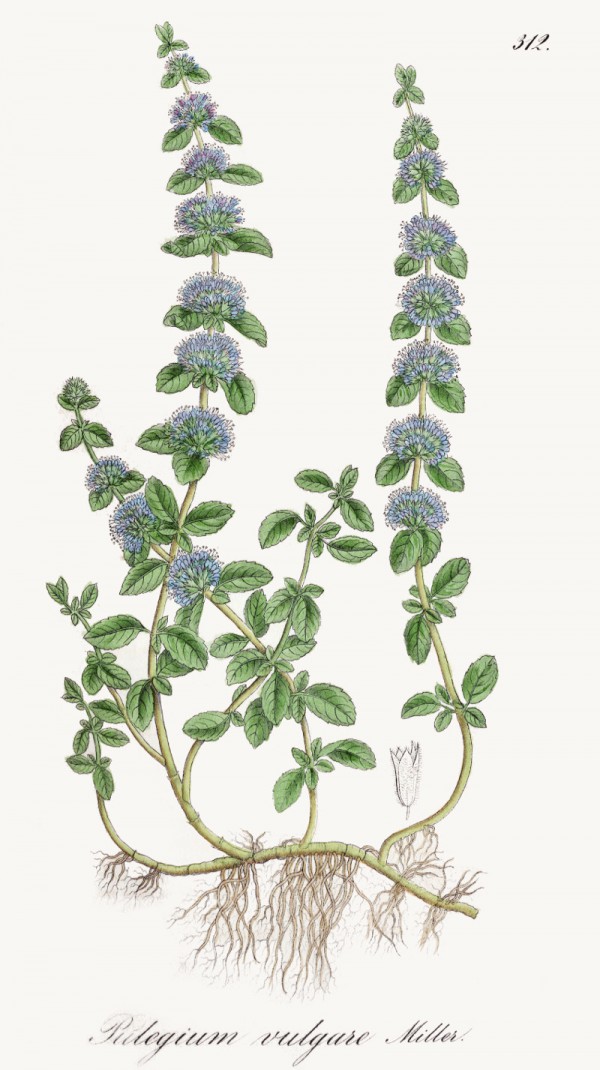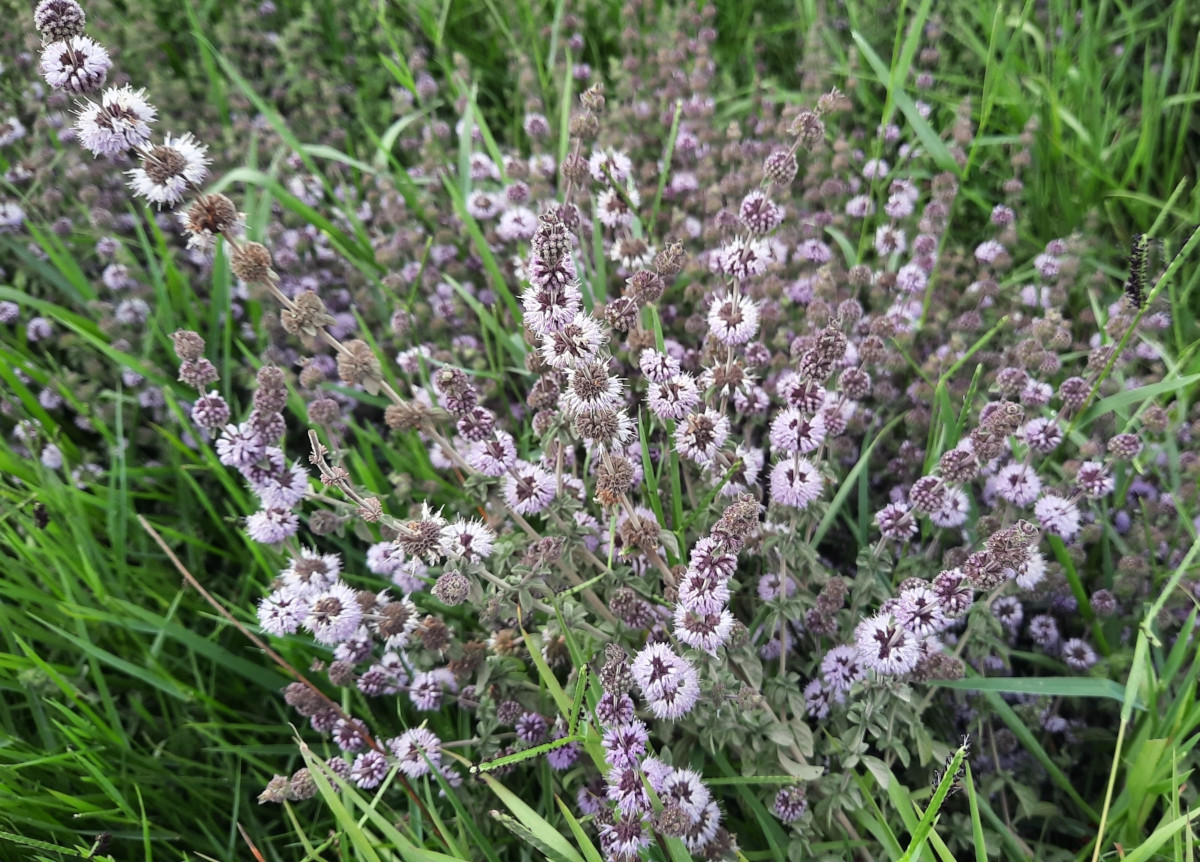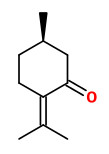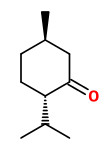Mentha pulegium L. - syn.Pulegium vulgare Mill. - Lamiaceae - pennyroyal, European pennyroyal, Polei-Minze
Perennial herb, to 40cm high, native to Europe, Northern Africa and Asia; camphor/peppermint scented; stems green to red, lower parts prostrate with roots at nodes; leaves opposite, sparsely to densely hairy, elliptic to oval; flower calyx tubular, uneven 5-lobed (nearly 2-lipped), corolla mauve (blueish-pink, or sometimes white).
„Pennyroyal was commonly used as a cooking herb by the Greeks and Romans…Pennyroyal essential oil should never be taken internally because it is highly toxic…“ wikipedia
„(R)-(+)-Pulegone, the major monoterpene component of the abortifacient mint oil, pennyroyal oil, is metabolized by hepatic microsomal monooxygenases of the mouse to a hepatotoxin. The formation of a toxic metabolite is apparently mediated by cytochromes P-450 of the phenobarbital class inasmuch as phenobarbital pretreatment of mice increases, whereas beta-naphthoflavone pretreatment decreases, the extent of hepatic necrosis caused by pulegone. Furthermore, two inhibitors of cytochromes P-450, cobaltous chloride and piperonyl butoxide, block toxicity. An analog of (R)-(+)-pulegone that was labeled with deuterium in the allylic methyl groups was found to be significantly less hepatotoxic than the parent compound. The results indicate that oxidation of an allylic methyl group is required for generation of a hepatotoxic metabolite. Menthofuran was identified as a proximate toxic metabolite of (R)-(+)-pulegone, and investigations with (R)-(+)-pulegone-d6 and 18O2 strongly indicate that menthofuran is formed by a sequence of reactions that involve: 1) oxidation of an allylic methyl group, 2) intramolecular cyclization to form a hemiketal, and 3) dehydration to form the furan.“
[The metabolism of the abortifacient terpene,(R)-(+)-pulegone, to a proximate toxin, menthofuran., Gordon, W.P., Huitric, A.C., Seth, C.L., McClanahan, R.H., Nelson, S.D., Drug Metabolism and Disposition, 15(5), 1987, 589-594]
„Pennyroyal continues to be an herbal toxin of public health importance… We report four cases of pennyroyal ingestion. One patient died, one received N-acetylcysteine, and two ingested minimally toxic amounts of pennyroyal and were not treated with N-acetylcysteine. In the fatal case, postmortem examination of a serum sample, which had been obtained 72 hours after the acute ingestion, identified 18 ng of pulegone per mL and 1 ng of menthofuran per mL. In a serum sample from the patient treated with N-acetylcysteine, which had been obtained 10 hours after ingestion, the menthofuran level was 40 ng/mL….
A review of cases of human intoxication with pennyroyal oil (Mentha pulegium: pulegone content 62-97%) indicate that ingestion of 10 ml resulted in moderate to severe toxicity and ingestion of greater than 15 ml (ca. 250 mg/kg bw for a 60 kg woman) resulted in death. The clinical pathology is characterised by massive
centrilobular necrosis, pulmonary oedema and internal haemorrhage.“
[Pennyroyal toxicity: measurement of toxic metabolite levels in two cases and review of the literature. Anderson, I. B., Mullen, W. H., Meeker, J. E., Khojasteh-Bakht, S. C., Oishi, S., Nelson, S. D., Blanc, P. D., Annals of internal medicine, Vol.124(8), 1996, 726-734] PDF
„Hydrodistillation of the aerial parts of Mentha pulegium L., collected from the wild and recorded for the first time from different locations in the higher Himalayas, Jammu and Kashmir, India, provided refreshing pale-coloured essential oils with a characteristic minty flavour. Essential oils from different locations were qualitatively similar and were found to be a complex mixture of at least 45 compounds, of which 24 were identified. Eight compounds accounted for about 87-98% of the oil and were characterized as pulegone (65.9-83.1%), menthone (8.3-8.7%), isomenthone (3.8-4.0%), neo-menthol (0.7-1.3%), pulegol acetate (0.1-1.2%), piperitone (1.3-3.2%), γ-terpinene (0.9-1.2%), β-caryophyllene (0.1-0.9%) and β-caryophyllene oxide (0.3-1.9%) by capillary GC, GC-MS, 1H-NMR and 13C-NMR.“
[Agnihotri, V. K., Agarwal, S. G., Dhar, P. L., Thappa, R. K., Baleshwar, Kapahi, B. K., Saxena, R. K. and Qazi, G. N. (2005), Essential oil composition of Mentha pulegium L. growing wild in the north-western Himalayas India. Flavour Fragr. J., 20: 607-610. doi: 10.1002/ffj.1497]
The major component of M.pulegium collected in Morocco was piperitone (35.5%), other compounds present were piperitenone (21.1%), α-terpineol (10.8%), pulegone (6.4%), piperitone oxide (4.0%), menthol (3.2%), menthone (3.0%), neomenthol (2.8%), menthofuran (2.1%), isomenthone (1.5%), carvone (1.1%), geranyl acetate (1.0%), germacrene D (1.0%) and limonene (1.0%).
[GC/MS analysis of volatile compounds of the essential oil of the leaves of Mentha pulegium growing in Morocco, E. Derwich, Z. Benziane, R. Taoui, Chem Bull POLITEHNICA Univ, Vol.55(69), 2010, 103-106] PDF
„The composition of the essential oil obtained from the dried flowering aerial parts of Mentha pulegium L. (Lamiaceae) was analyzed by GC and GC-MS. Fifty-five components have been identified in the essential oil of M. pulegium. The major constituents of the essential oil were pulegone (54.6%) and menthone (15.1%).“
[Chemical composition and antimicrobial activity of essential oil of Mentha pulegium L. Morteza-Semnani K, Saeedi M, Akbarzadeh M. Journal of essential oil-bearing plants JEOP 01/2011]
„The essential oil revealed menthone, pulegone and neo-menthol as the main constituents, comprising 35.9, 23.2 and 9.2% of the essential oil, respectively.“
[European pennyroyal (Mentha pulegium) from Portugal: Chemical composition of essential oil and antioxidant and antimicrobial properties of extracts and essential oil. [Bárbara Teixeiraa, António Marques et al. Industrial Crops and Products, Volume 36, Issue 1, March 2012, 81-87]
Main components of the essential oil of Mentha pulegium growing in Turkey were isomenthone (42%), pulegone (28%), piperitenone (12%) and piperitone (12%).
[Yasa, Hasniye, Hülya Çelik Onar, and Ayse Sergüzel Yusufoglu. „Chemical composition of the essential oil of Mentha pulegium L. from Bodrum, Turkey.“ Journal of Essential Oil Bearing Plants 15.6 (2012): 1040-1043]
„The chemical composition and the biological activities of Mentha pulegium leaves extracts were evaluated. The main components of M. pulegium EO were menthone (41.7%), cis-isopulegone (31.71%) and isomenthone (15.03%).“
[Chemical Composition and in vitro Antimicrobial Activities of Mentha pulegium Leaves Extracts against Foodborne Pathogens. Ghazghazi, Hanene and Chedia, Aouadhi and Weslati, Moufida and Trakhna, Faten and Houssine, Sebei and Abderrazak, Maaroufi and Brahim, Hasnaoui, Journal of Food Safety, Volume 33, Issue 3, pages 239-246, August 2013]

Mentha pulegium L. as Pulegium vulgare Miller
Dietrich,A.G., Flora regni borussici, vol.5, t.312 (1837)
http://plantgenera.org/species.php?id_species=659415

Mentha pulegium, São João de Loure e Frossos, Portugal (2025) © Samuel Patinha CC BY-SA 4.0 inaturalist.org


